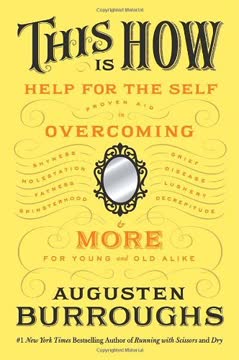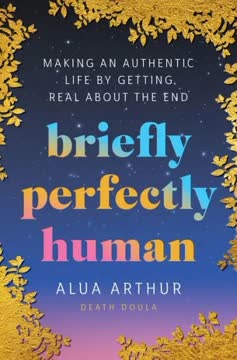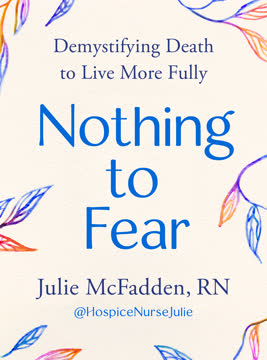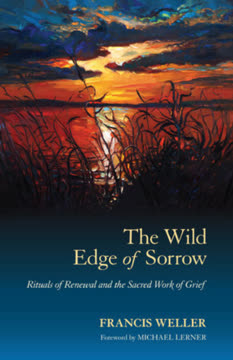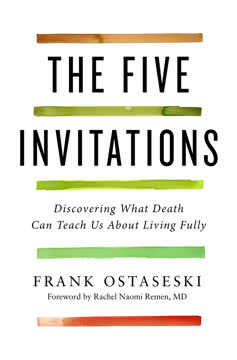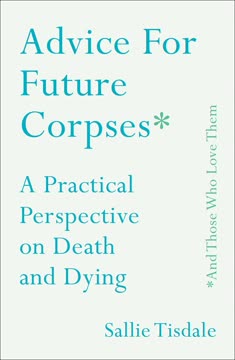Key Takeaways
1. Confronting Our Mortality: Life's Dangerous Situation
Life, he wrote, “is a dangerous situation.”
Embracing fragility. We often live in denial of death, a stark contrast to Victorian times when children witnessed deathbeds. Modern society shields us, making death a theoretical concept until it becomes personal. The author's early experiences, like her grandfather's unexplained death and cadaver dissection, fostered an equanimity towards life's inevitable end.
A universal truth. Birth and death are the only human acts we cannot practice, yet they define our existence. The Buddhist perspective, exemplified by Siddhartha's awakening to sickness, aging, and death, highlights that impermanence is the key to both our pain and our joy. This fragility opens our hearts to the preciousness of life.
The china bowl. The beauty of a china bowl lies in its eventual breakage, a metaphor for our precarious lives. This understanding, that "a problem for everything is not a problem anymore," offers a vast space for living. It reminds us that everything is compounded and will dissolve, including ourselves, making each moment extraordinary.
2. The Nature of Resistance: Our Deep-Seated Denial
I am of the nature to grow old. I am of the nature to be sick. I am of the nature to die.
The illusion of exemption. Despite knowing death is universal, we secretly believe it won't happen to us, not now, not here. This internal contradiction, this "blinkered, partial denial," is a fundamental human trait. The author's own fear of flying, initially irrational, revealed itself as a naked fear of dying, a reminder of life's constant danger.
Unspoken fears. We harbor countless unspoken fears about death: pain, loneliness, loss of dignity, becoming a burden, or the unknown afterlife. These anxieties, often repressed, drive us to create meaning in our lives and build civilizations. However, confronting these fears, as many religions encourage, can lead to liberation rather than despair.
Accepting resistance. Elisabeth Kübler-Ross's work with dying people identified coping mechanisms like denial, anger, bargaining, depression, and acceptance, not as linear stages, but as fluid emotional experiences. True acceptance often begins by acknowledging our resistance and disbelief. It's about seeing our fear for what it is, rather than trying to bypass it.
3. Defining a "Good Death": A Personal and Fitting End
The value of a death doesn’t depend on what anyone else thinks about it.
Beyond ideals. A "good death" is often idealized as pain-free, peaceful, and surrounded by loved ones, but this can be a constricting fantasy. Death is messy, noisy, and unpredictable. Focusing on supporting the conditions of dying—allowing choices, treating symptoms according to the dying person's wishes, and respecting their autonomy—is more realistic and compassionate.
Individual choices. What constitutes a fitting death is deeply personal.
- Perry, a veteran, chose to "die like an animal"—alone, silent, refusing most medications and personal care, embracing the body's natural dissolution.
- The motorcyclist died instantly in an accident, likely without warning, yet his life reflected his love for riding.
- Carol, the author's friend, chose to fight for life until the very end, even if it meant dying in a hospital during resuscitation.
Dignity redefined. The fear of losing dignity often drives choices, but true dignity arises from inherent worth, not control over physical functions. It's about being seen exactly as one is—vulnerable, broken, afraid—and cultivating an attitude of curiosity and willingness, even when the mind is failing.
4. The Art of Communication: Listening and Honesty
Listening isn’t that complicated. It’s hard, but it’s not complicated.
The power of presence. When with a dying person, listening is paramount. It means being fully present, inviting detail, asking questions, and reflecting what you hear without judgment. This deep listening creates a space for the dying person to express their needs, fears, and wishes, even if they are vague or symbolic.
Setting boundaries. Caregivers become protectors and gatekeepers, managing visitors and ensuring the dying person's desires for privacy, silence, or specific activities are honored. It's crucial to be honest about one's own emotional limits and to offer specific, deliverable help, rather than vague promises.
What not to say. Avoid platitudes, euphemisms, and attempts to "fix" or cheer up the dying person. Do not deny their reality, impose your beliefs, or make their death about your own grief. Instead, offer love, reassurance, and permission to feel whatever they feel, acknowledging that their journey is uniquely theirs.
5. Navigating the Last Months: Changes and Comforts
The first and one of the hardest tasks of dying and caring for the dying is to accept that things will never be the same.
Profound shifts. Terminal illness brings profound changes, both physical and emotional. Fatigue, a mysterious and debilitating lack of vital energy, becomes a constant companion. Roles and identities shift, forcing a letting go of the "old self" and a discovery of a new, more vulnerable one.
Managing symptoms. Pain, though a common fear, is manageable for most dying people with proper care. Morphine, the gold standard, is safe and effective, and concerns about addiction are usually unfounded. Other symptoms like nausea, loss of appetite, and changes in bowel control are also common and require compassionate, practical management, respecting the person's diminishing desire for food and drink.
The meaning of loss. Dying is a state of ongoing loss—of physical abilities, relationships, and future plans. This can lead to depression or demoralization, a bleak but honest appraisal of reality. The psychological and spiritual work of finding meaning in one's death is deeply individual, a quest for coherence and wholeness in the face of dissolution.
6. Choosing Where to Die: Home, Hospice, and Hospitals
You can have a bad death in your own bed and a good death in an ICU.
The complexities of "home." While many idealize dying at home, it's often a mixed blessing. Untrained family caregivers may struggle with complex medical needs, and the home environment itself might not be suitable. Hospitals, often seen as sterile, can offer professional, round-the-clock care and a sense of security that a fragile person might prefer.
Hospice realities. Hospice services, while invaluable, are often misunderstood. "Home hospice" typically provides limited face-to-face care, relying heavily on family caregivers. Eligibility criteria can be strict, and the Medicare benefit requires giving up curative treatments, which can conflict with cultural or religious beliefs. Palliative care, by contrast, offers comprehensive support for quality of life alongside curative treatments.
Advocating for care. Regardless of location, insisting on good care is crucial. This means finding doctors who communicate openly, managing symptoms effectively, and ensuring the dying person's wishes are honored. A "good hospital" or care facility prioritizes comfort, privacy, and respectful attention, allowing the dying person to lead their own journey.
7. The Last Days: Physical Signs and Emotional Labor
Dying is not a passive event. We can’t control it, but we do participate in it. We aren’t simply watching or waiting for something to happen to us. We are dying, and this is a verb. An act.
Predictable changes. As death nears, profound weakness, loss of bodily control, and changes in circulation are common. Breathing patterns become uneven, and noisy breathing (the "death rattle") is normal, often more distressing to observers than to the dying person. Comfort is the paramount concern, guiding all interventions.
Confusion and agitation. Dying people often experience confusion or delirium, which can be caused by various factors or simply be a "blunt expression of emotion." Terminal agitation, a sudden burst of energy, can be dramatic. It's vital to rule out treatable causes, reduce stimuli, and offer reassurance, understanding that these are often part of the "labor of letting go."
Spiritual and existential suffering. Beyond physical pain, psychological, emotional, and spiritual distress can be profound. People may feel "held back" by unresolved issues or terror at judgment. Palliative sedation, a last resort, can allow a person to sleep through intractable suffering, ensuring a painless death when all other treatments have failed.
8. The Moment of Transition: A Profound Stillness
For the first time since conception, the body is still. Stopped.
The final breath. The moment of death is not a single instant but a long, ambiguous transition. Breathing may slow, stop, and restart, making it difficult to pinpoint the "last breath." Even after breathing ceases, minuscule electrical signals may fire in the brain for a few minutes. The body, once a system in motion, becomes a body at rest, a profound object lesson in stillness.
A social agreement. The "time of death" is as much a social and legal agreement as a clinical one, with definitions varying across cultures and medical contexts. Whether it's the last heartbeat, breath, or brainwave, the cessation of the body's organized systems marks the end of the drive to live.
Beyond the physical. While the body undergoes irreversible changes, the experience of death itself remains a mystery. Some describe spiritual experiences or "deathbed phenomena," seeing invisible figures or visiting other worlds. These moments, whether biochemical or spiritual, often bring peace to the dying and comfort to witnesses, suggesting that death is not lonely.
9. After the Body: Choices for Disposal and Meaning
The corpse is a mirror; we are its reflection.
Ritual and respect. What happens to the body after death carries immense ritual weight, reflecting our attitudes towards life and loss. From ancient practices of exposure to modern embalming, choices vary widely, but all serve to honor the deceased and help the living cope with the finality of absence.
Embalming and its alternatives. Embalming, a relatively modern practice in the West, is not legally required in most cases and is often seen as an "art of complete denial," creating a false image of life. Alternatives like natural burial, where the body decomposes naturally, or newer methods like resomation (alkaline hydrolysis) and promession (cryogenic freezing and pulverization), offer more ecologically sensitive and often more direct ways to return to the earth.
The cycle of decomposition. Regardless of the method, all bodies eventually decompose, returning to the earth. This process, whether slow in the soil or rapid through cremation or resomation, transforms the body into its component parts, feeding new life. This "equality in the presence of the maggot" can be a profound vision of the fullness of birth and death.
10. The Journey of Grieving: Disruption and Renewal
Grief is the frozen moment when you pat your pocket for your keys, the pocket where you always put your keys, and your keys aren’t there.
A profound disruption. Grief is a deeply physical and psychological disruption, a "derangement" where the familiar is suddenly gone. It's not a linear process but a swirling, recurring experience of shock, numbness, anger, guilt, and profound sadness. It can make one feel unreal, forgetful, and disoriented, as if time itself has changed.
No quick fix. Grief is not a disease to be cured; it's a wound that heals, leaving a scar but never quite the same tissue. Platitudes, explanations, or advice rarely help. Instead, what's needed is compassionate listening, allowing the grieving person to tell their story repeatedly, without judgment or attempts to rush their process.
Transformation through loss. While painful, grief offers an opportunity for profound transformation. It forces us to confront our deepest fears and attachments, revealing what truly matters. Over time, the intense pain may evolve, allowing for a new life to be built, one that cherishes the lost loved one without reservation, accepting that "you can never be happy and the same again."
11. Finding Joy in Impermanence: The Beauty of Fleeting Life
The nowness of everything is absolutely wondrous.
The strawberry moment. The ancient fable of the wanderer dangling over two tigers, nibbling a wild strawberry, illustrates life's precarious beauty. Despite the ever-present danger of death, there are moments of pure, unadulterated joy and presence. This "nowness of everything" becomes intensely vivid when mortality is confronted.
Beauty in fading. We are drawn to the poignant beauty of fleeting things: spring blossoms, autumn colors, twilight. This appreciation for impermanence is a deep understanding that the things we love are beautiful precisely because they will break and leave us. It's the recognition that life, in its swift, changing nature, is luminous and extraordinary.
Unconditional cherishing. After a death, the fear that holds us back from complete love dissolves. There is nothing more to lose, freeing our hearts to cherish without reservation. Grief, in this sense, becomes an opportunity to fully embrace love, knowing that even in dissolution, life continues in new forms—ant, frog, eagle, egg—a testament to everlasting change.
12. Preparing a Death Plan: An Act of Compassion
We make a death plan because we can—for our own peace of mind, and as an act of compassion for the people nearest to us who will be left, quite literally, holding things.
A gift to loved ones. Creating a death plan is a profound act of kindness, sparing grieving family members from difficult decisions and potential conflicts. It involves detailing wishes for where and how to die, religious services, desired comforts, and who should be present or excluded.
Essential documents. Key legal and personal documents to prepare include:
- Will: Specifies distribution of assets and names an executor.
- Advance Directive (Living Will): Explains wishes for life-sustaining treatments (ventilators, tube feeding, antibiotics) if unable to decide.
- POLST (Physician's Order for Life-Sustaining Treatment): A legal doctor's order for those in poor health, guiding critical medical decisions.
- Health Care Representative/Power of Attorney: Appoints someone to make medical decisions, ideally assertive and aligned with your wishes.
Beyond the legal. A death plan also covers personal details:
- Disposal of the body: Preferences for burial, cremation, or alternative methods.
- Personal possessions: Instructions for photographs, letters, diaries, and even unfinished manuscripts.
- Digital legacy: Passwords, online accounts, and social media profiles.
- Pets: Arrangements for their care.
Open conversations. Discussing these wishes with your doctor, family, and chosen representatives is crucial. Regularly review and update the plan, ensuring it reflects current desires. This proactive approach provides peace of mind and ensures that your final journey aligns with your values.
Last updated:
Review Summary
Similar Books
